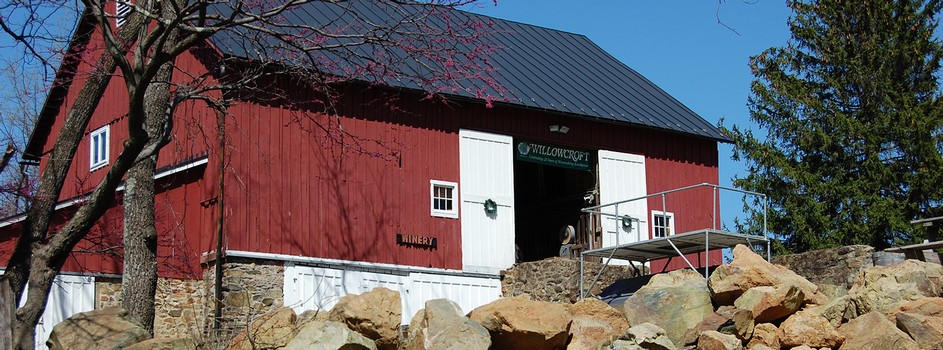News
Welcome to the Willowcroft blog! This is where we will be highlighting events and news from around the winery.
The Truth About Corked Wine - Part I

Part 1: What Does It Mean When a Wine Is Corked?
Have you ever opened a bottle of wine, poured a glass, and thought something smelled off – like a damp basement or wet cardboard? If so, you likely encountered a “corked” wine. Don’t worry, you’re not alone. Corked wine is a common wine fault that even seasoned wine lovers run into occasionally.
Let’s start with the basics: a corked wine doesn’t have cork bits or a dry cork floating in it. Instead, it refers to a wine tainted by TCA (2,4,6-trichloroanisole), a compound that can form when natural fungi in cork come into contact with certain chlorine-based substances. TCA causes a musty, moldy smell that overwhelms the wine’s natural aromas.
How Common Is Corked Wine?
Today, cork taint affects an estimated 3–5% of wines sealed with natural cork. That means about 1 in 20 bottles might be corked. Thanks to modern cork processing improvements, rates have dropped from historical highs of 5–10%, but it still happens.
How to Recognize It
- Tell-tale signs of a corked wine include:
- A musty, moldy smell (wet dog, cardboard, damp basement)
- Muted or missing fruit aromas
- Flat or dull taste that doesn’t improve with air
Some people are more sensitive to TCA than others, so if a wine tastes or smells lifeless and unpleasant to you, trust your instincts.
Coming Next Week: Part II - We’ll dive into whether corked wine can be saved, how to handle it when it happens, and why some wines are more at risk than others.
Wine Grapes vs. Table Grapes: What’s the Difference?
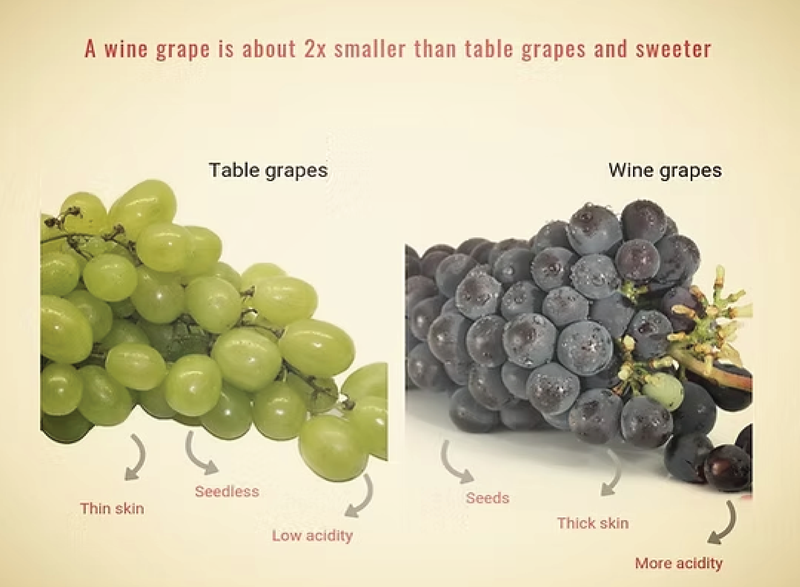
When you walk through the produce aisle, you’ll find plump, juicy grapes ready for snacking. But step into a vineyard, and the grapes look quite different—smaller, darker, and often less sweet. So, what sets wine grapes apart from table grapes (sometimes used for jelly and juice)? It all comes down to size, skin thickness, sugar levels, seeds, and purpose.
1. Size & Appearance
- Smaller and more compact in clusters.
- Thick skins and a higher ratio of skin to juice, contributing to deep color and tannins.
- Often darker and more intense in hue for reds; golden or green for whites.
- Larger, plumper, and juicier.
- Thinner skins for easy eating.
- Uniform in color, often bright green or deep red, bred for visual appeal.
2. Sugar & Acidity Levels
Wine grapes have higher sugar content (24-28% sugar, or 24-28° Brix) to allow for fermentation into alcohol.
- Table grapes contain less sugar (typically around 15-17° Brix) and more water, making them refreshing but unsuitable for winemaking.
- Wine grapes maintain higher acidity, which is crucial for balance in winemaking, while table grapes are milder in acidity, making them sweeter to eat.
3. Seeds vs. Seedless
- 🍷 Wine Grapes: Typically contain seeds, which contribute to tannins in the winemaking process. Some varieties (like Sémillon) can be nearly seedless but are rare.
- 🍇 Table Grapes: Usually seedless for convenience, thanks to selective breeding.
4. Purpose: Eating vs. Winemaking
- Table grapes are bred for fresh consumption, meaning they focus on crisp texture, juiciness, and mild sweetness.
- Wine grapes are grown to be fermented into wine, meaning they need higher sugar, acidity, tannins, and complex flavors to create a balanced final product.
5. Growing Conditions & Farming Practices
- Dry-farmed or minimally irrigated, allowing deep roots to pull minerals from the soil.
- Lower-yielding vines (grapes per vine) to concentrate flavors.
- Harvested once per season at peak ripeness, often by hand for premium wines.
- Heavily irrigated for plumpness.
- Grown for high yields, meaning more grapes per vine but with less concentrated flavors.
- Often harvested multiple times for consistent supply.
Technically, yes—but it won’t taste great. Because table grapes have lower sugar and acidity and higher water content, any wine made from them would be diluted, overly sweet, and lacking in depth. Table grape skins also contain fewer tannins, which means red wine made from them won’t have the structure or aging potential of true wine grapes.
While both table grapes and wine grapes come from the Vitis family, their differences make them suited for entirely different purposes. Table grapes are bred for fresh eating—crisp, juicy, and mild—while wine grapes are cultivated for complexity, sugar, acidity, and depth, all necessary for crafting fine wine.
Next time you enjoy a glass of Willowcroft wine, remember that these grapes weren’t meant for snacking—they were grown with intention, patience, and tradition to bring out the best flavors in every sip. 🍷
Beyond the Fruit: Exploring the Vegetal Notes in Your Favorite Wines
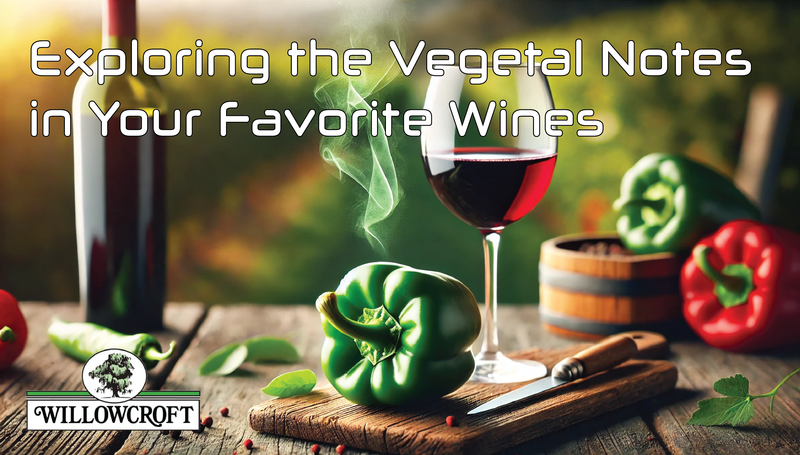 Have you ever sipped a glass of wine and detected a distinct green pepper aroma or flavor? This surprising characteristic is primarily attributed to methoxypyrazines—naturally occurring compounds in certain grape varieties. Understanding their role in wine can deepen your appreciation of different styles and help you recognize how viticulture and winemaking choices influence flavor.
Have you ever sipped a glass of wine and detected a distinct green pepper aroma or flavor? This surprising characteristic is primarily attributed to methoxypyrazines—naturally occurring compounds in certain grape varieties. Understanding their role in wine can deepen your appreciation of different styles and help you recognize how viticulture and winemaking choices influence flavor.
Methoxypyrazines are highly aromatic compounds found in grape skins and stems. They contribute to "green" flavors in wine, often reminiscent of green bell peppers, grass, or even cherry stems. Even small concentrations can significantly impact a wine’s aroma and taste.
While present in many grape varieties, methoxypyrazines are most noticeable in certain Bordeaux varieties, particularly:
- Cabernet Sauvignon – Often exhibits green pepper notes when grown in cooler climates or harvested before full ripeness.
- Cabernet Franc – Known for its distinct vegetal characteristics, contributing to its unique flavor profile.
- Merlot – Typically fruit-forward, but it can display subtle green pepper nuances under certain conditions.
Historically, vegetal notes were characteristic of red Bordeaux wines. However, with the rise of New World wine regions like California, which produced Bordeaux varieties with little to no green flavors, consumer preferences began shifting toward riper fruit profiles. Even Bordeaux winemakers adapted their practices to reduce pyrazine levels and meet modern taste expectations.\
Grape growers have substantial control over methoxypyrazine levels through vineyard management techniques:
- Canopy Management – Removing leaves and lateral shoots early in the growing season enhances sunlight exposure, reducing pyrazine accumulation.
- Vine Vigor & Water Management – High vine vigor and excessive irrigation lead to dense canopies, increasing pyrazine levels. Controlling water supply ensures optimal ripening.
- Harvest Timing – Allowing grapes to ripen fully naturally decreases methoxypyrazine concentrations, leading to more fruit-forward flavors.
At Willowcroft Farm Vineyards, we take great care in our vineyard practices to ensure our grapes reach full ripeness, preventing overwhelming green pepper flavors. Our approach includes:
- Dry Farming – Relying solely on natural rainfall encourages deep root growth and balanced vine vigor, leading to optimal fruit ripeness.
- Site Selection – Our vineyards sit atop the Catoctin Ridge at elevations of 600 to 750 feet, where warm summer days and cool nights create ideal ripening conditions.
- Canopy Management – Timely leaf removal in the fruit zone enhances sunlight penetration and airflow, reducing disease risk and promoting even ripening.
We employ these strategies to produce wines with beautifully ripened fruit flavors, balanced acidity, and complexity—without dominant green pepper notes.
Not all drinkers perceive green pepper notes the same way—some enjoy the added complexity, while others find it distracting. Interestingly, methoxypyrazine-derived aromas evolve as wines age into subtler characteristics like menthol or tobacco, adding depth to the wine.
The presence of green pepper in wine is a fascinating example of how grape variety, vineyard management, and winemaking techniques shape a wine’s final profile. Understanding where these flavors come from and how they can be influenced allows for a deeper appreciation of wine’s complexity. At Willowcroft, we take pride in crafting wines highlighting rich, ripe fruit flavors while maintaining balance and elegance in every bottle.
Sip, Savor, Say 'I Do': A Guide to Choosing the Perfect Wedding Wines
 As spring nears and love blooms, wedding season comes into full swing. Whether planning an intimate gathering or a grand celebration, selecting the right wines can enhance the joy of your special day. Here are a few tips to help you choose the perfect wines for your wedding reception.
As spring nears and love blooms, wedding season comes into full swing. Whether planning an intimate gathering or a grand celebration, selecting the right wines can enhance the joy of your special day. Here are a few tips to help you choose the perfect wines for your wedding reception.
Start with What You Love
A wedding celebrates love, and your wine choices should reflect your tastes as a couple. Begin by scheduling a wine tasting (or two) at your favorite local wineries. Sample a variety of options and get a consensus between you and your partner before making a final decision. Selecting wines you both enjoy will make the experience more personal and memorable.
Consider the Time of Year
Seasonality plays a big role in choosing the right wines. For spring and summer weddings, lighter, more refreshing wines are ideal to complement the Virginia heat. A crisp Seyval Blanc or Chardonnay makes an excellent springtime white, while Vidal Blanc and Riesling offer excellent choices for summer. Regarding reds, lighter-bodied options like Chambourcin, Pinot Noir, or a refreshing Rosé are great for warmer months. For fall and winter weddings, bolder wines like Cabernet Sauvignon and Petit Verdot may be more suitable.
Think About the Time of Day
The timing of your wedding can also influence your wine selection. Afternoon weddings typically call for lighter wines like Seyval Blanc or Pinot Noir to keep the mood bright and refreshing. When temperatures cool, evening receptions allow for fuller-bodied options, making a bold red like a rich Cabernet Sauvignon a great choice to pair with a hearty dinner.
Pair Wines with Your Menu
Food and wine pairings can elevate the dining experience at your wedding. While your caterer may have recommendations, here are some general guidelines to consider:
- Seyval Blanc: Pairs beautifully with oysters, seafood, and spicy dishes.
- Chardonnay: A versatile white that complements salmon, poultry, and scallops.
- Chambourcin: A great match for poultry, lamb, and pork.
- Cabernet Sauvignon: A bold red that pairs exceptionally well with steak and other red meats.
By taking into account your personal preferences, the season, and your menu, you can create a delightful wine experience for you and your guests. Cheers to love, laughter, and happily ever after!
Merlot Vs. Petit Verdot. How to choose...
 Merlot and Petit Verdot are two prominent red grape varieties that have found a welcoming home in Virginia's vineyards, each offering distinct characteristics that appeal to wine enthusiasts.
Merlot and Petit Verdot are two prominent red grape varieties that have found a welcoming home in Virginia's vineyards, each offering distinct characteristics that appeal to wine enthusiasts.
Merlot originated in Bordeaux, France, and is celebrated for its approachability and versatility. Typically, Merlot is a dry, medium- to full-bodied wine with moderate acidity, moderate to high alcohol content, and soft but present tannins. Flavor profiles often include notes of black cherry and chocolate.
Petit Verdot, also hailing from Bordeaux, is traditionally used as a blending grape but has gained recognition as a varietal wine, especially in regions like Virginia. Known for its late ripening, Petit Verdot produces deeply colored, full-bodied wines with high tannin levels. Flavor profiles often include rich blue and black fruit flavors, dominated by blackberry, blueberry, black currant, and black cherry. The wines can also be quite spicy, displaying aromatic floral and herbal character—showcased by violet, lavender, and dried herbs—and sometimes meaty, gamey notes.
In Virginia, both Merlot and Petit Verdot have adapted well to the state's diverse terroir. Merlot thrives in Virginia's clay-rich soils, making it the second most planted grape in the state. Petit Verdot has become one of Virginia's signature grapes, valued for its high acidity, which it retains despite the state's hot summers, and its resilience to varying weather conditions.
At Willowcroft Farm Vineyards, nestled atop the Catoctin Ridge in Leesburg, Virginia, both Merlot and Petit Verdot grapes are cultivated to produce distinctive wines that reflect the unique terroir of the region. Their Merlot offers a harmonious balance of fruit and tannins, while their Petit Verdot showcases the grape's characteristic depth and complexity.
Choosing Between Merlot and Petit Verdot
When deciding between Merlot and Petit Verdot, consider your personal taste preferences and the occasion. Merlot's softer tannins and approachable fruit flavors make it a versatile choice suitable for various settings, from casual gatherings to formal dinners. It's an excellent option for those who appreciate a smooth, fruit-forward wine that pairs well with a wide range of dishes, including roasted meats, pasta, and mild cheeses.
On the other hand, Petit Verdot offers a more robust and intense experience. Its full body, higher tannin content, and complex flavor profile make it ideal for those who enjoy bold wines. Petit Verdot pairs exceptionally well with rich, hearty dishes such as grilled steaks, lamb, and strong cheeses, enhancing the dining experience with its depth and structure.
Ultimately, the choice between Merlot and Petit Verdot depends on your palate and the culinary context. Exploring both varietals, especially those produced by local wineries like Willowcroft Farm Vineyards, can provide a deeper appreciation for the diversity and quality of Virginia wines.
Why Your Wine Glass Isn’t Full—And Why That’s a Good Thing!
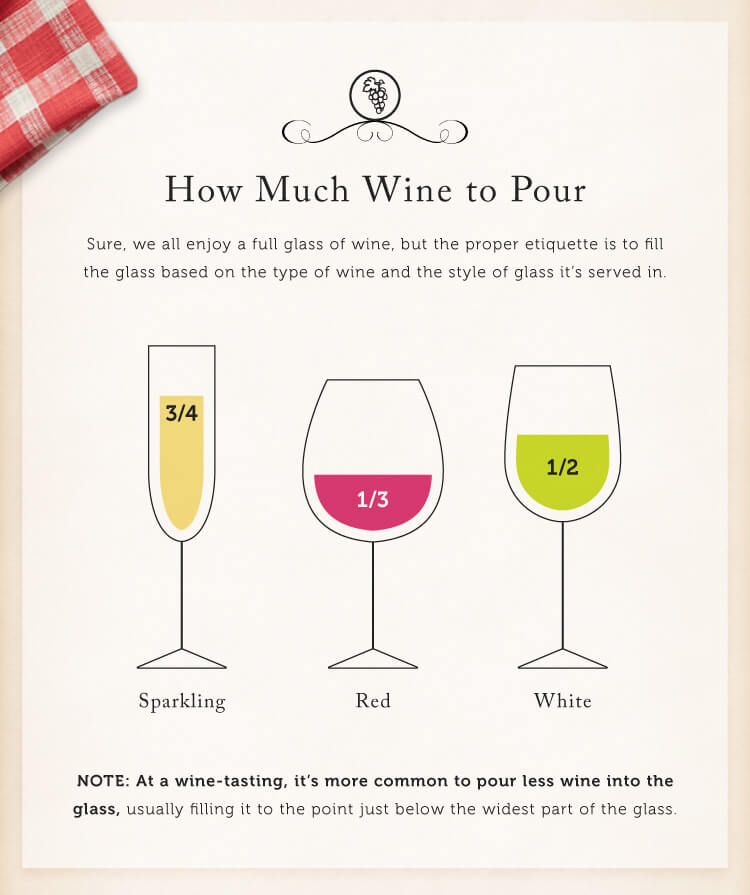
How Full Should You Fill Your Wine Glass?
Have you ever ordered a glass of wine and felt a pang of disappointment when it arrived looking half-empty? It’s a common reaction, but before you feel shortchanged, let’s talk about why wine glasses aren’t filled to the brim.
The Ideal Pour
The amount of wine poured into a glass isn’t just about aesthetics; it plays a crucial role in the wine’s taste and aroma. Generally, the ideal pour is about one-third to one-half full, depending on the type of wine and the glass itself. This may seem like a small amount, but there’s a good reason for it.
Why Not Fill It to the Top?
Wine needs room to breathe. When a glass is only partially filled, there’s ample space to swirl the wine, which helps release its aromas. This is especially important for red wines, known for their complex flavors and rich aromas, which benefit from aeration to open up their full bouquet of flavors. If a glass is filled to the brim, there’s no space for swirling, and the wine’s aromas remain trapped, limiting the tasting experience.
Different Wines, Different Pours
Not all wines are poured the same way. Here’s a general guideline:
- Red wine: Typically poured to about one-third full to allow proper aeration and development of flavors.
- White wine: Often poured slightly more, around one-half full, since it doesn’t require as much aeration. A standard serving is 5 ounces (150 milliliters), as recommended by the FDA, USDA, and CDC.
- Sparkling wine: Poured closer to three-quarters full to help preserve the bubbles and prevent excessive foaming.
- Dessert wine: Served in smaller glasses with smaller pours due to their higher sugar and alcohol content.
The Right Glass Matters
The structure of a wine glass plays a significant role in enhancing the wine’s characteristics. Oxygenation softens tannins in reds and enhances the delicate characteristics of whites, allowing for a smoother and more enjoyable drinking experience.First things first: let’s talk about the glass itself. In general, red wine glasses are taller and feature a larger bowl. This is because red wines tend to be big and bold, requiring the extra space to fully experience their flavors and aromas. White wine glasses are typically smaller to preserve the aromas and keep the temperature cooler. The simplest method is to fill red wine glasses one-third full so you have room to give it a good swirl and aerate the wine, while white wine glasses should be filled half-full and sparkling wines about three-quarters full.
Don’t Feel Cheated—Savor the Experience
Instead of viewing a partially filled wine glass as a short pour, think of it as the perfect way to enjoy wine as intended. The space in the glass is just as important as the wine itself, allowing the aromas to develop, the flavors to shine, and the overall experience to be enhanced.
So, next time you receive a seemingly half-full glass, take a moment to swirl, sniff, and savor—because good wine is about more than just quantity; it’s about quality and experience!
Cheers to Friendship: Celebrate Galentine’s Day in Style!
Cheers to Friendship: Celebrate Galentine’s Day in Style!
February 13th isn’t just any day—it’s Galentine’s Day, a time to celebrate the incredible friendships that bring joy, laughter, and support into our lives. Whether you’re single, in a relationship, or somewhere in between, Galentine’s Day is all about appreciating the incredible women in your life and making memories together.
What is Galentine’s Day?
Originally coined by the beloved character Leslie Knope from Parks and Recreation, Galentine’s Day has since evolved into a widely celebrated occasion. It’s a day to gather your besties, enjoy great food, and toast to the bond of friendship—because love isn’t just romantic. It’s also found in the people who stand by us through thick and thin.
How to Celebrate Galentine’s Day
If you're looking for a reason to get your favorite people together, here are a few fun and fabulous ideas to make your Galentine’s Day celebration unforgettable:
- 🍷 Wine Tasting Party
What better way to celebrate than with a fabulous wine-tasting experience? Whether you host at home or visit a local winery, sampling a variety of wines with perfectly paired bites is a great way to indulge in a little luxury. Bonus points for creating your own custom Galentine’s-themed charcuterie board! - 🥂 Brunch with a Mimosa Bar
A brunch gathering with your besties is the ultimate way to kick off a day of celebration! Set up a DIY mimosa or mocktail bar with different juices, fresh fruit garnishes, and bubbly to create a colorful and festive drink station. Pair it with heart-shaped waffles, eggs benedict, and some sweet treats for a meal that’s as fun as it is delicious. - 🍫 Fondue & Chocolate Night
If you love all things chocolate, consider hosting a fondue night! Melt dark, milk, and white chocolate for dipping strawberries, marshmallows, pretzels, and more. For a savory twist, go with cheese fondue and serve it with bread, veggies, and charcuterie. It’s interactive, indulgent, and the perfect way to bond over great food. - ☕ Fancy High Tea
Channel your inner royalty with an elegant afternoon tea party! Set the table with vintage teacups, tiered trays filled with finger sandwiches and pastries, and a selection of flavored teas (or maybe some bubbly). Add a fun dress code for extra flair—think floral dresses, pearls, and fascinators!
The Bottom Line: Friendship is Worth Celebrating
At the end of the day, Galentine’s Day is all about love, appreciation, and quality time with the people who mean the most to you. Life is too short not to celebrate the friendships that lift us up and make every day brighter. So, whether you’re toasting with wine, sharing a laugh over brunch, or indulging in sweet treats, take the time to spread the love and cherish the friendships that make life beautiful.
How are you celebrating Galentine’s Day this year? Let us know in the comments! 💕
Elevate Your Home Wine Tasting: Tips for a Memorable Experience with Willowcroft Wines
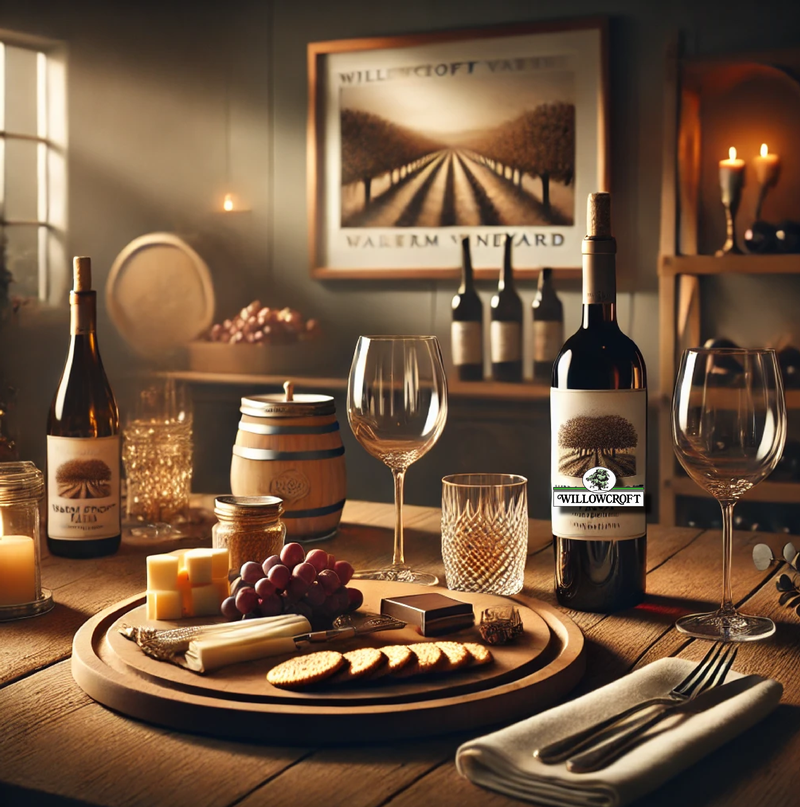
Elevate your home wine-tasting experience by incorporating selections from Willowcroft Farm Vineyards, Loudoun County's original winery. Here's how to create an engaging and educational tasting event:
- 1. Choose a Theme
Selecting a theme gives structure to your tasting. Consider:
- 🎨 Varietal Exploration: Compare wines made from the same grape grown in different regions.
- 🌎 Regional Focus: Showcase wines from a specific country or area.
- 🕰️ Aging Process: Taste the difference between young and aged wines.
- 2. Curate Your Wine Selection
Select a mix of white, red, and perhaps a sparkling or dessert wine. For example:
- 🍇 A crisp Seyval
- 🍷 A smooth Chambourcin
- 🌟 A refreshing sparkling wine
- 3. Prepare the Tasting Environment
- 🥂 Glassware: Use clear wine glasses, ideally one for each wine.
- 🍞 Palate Cleansers: Offer plain crackers or unsalted bread to reset between sips.
- ✨ Ambiance: Set the mood with soft lighting, candles, and a clean table or counter for serving.
- 4. Pair with Complementary Foods
Enhance the tasting with simple, versatile pairings:
- 🧀 Seyval: Goat cheese or feta
- 🧀 Chambourcin: Gruyere or mushroom-based dishes
- 🧀 Cabernet Sauvignon: Aged cheddar or blue cheese
- 🍫 Dessert Wine: Dark chocolate or berry desserts
- 5. Make It Interactive
- ✍️ Tasting Notes: Provide small cards or notebooks for guests to jot down their impressions.
- 🕶️ Blind Tastings: Cover labels and let guests guess the wine’s varietal or origin.
- 🎉 Friendly Competition: Reward the best guesser with a bottle of wine!
- 6. Share the Experience
- Take photos of your setup and pairings, and tag your favorite local winery (like Willowcroft Farm Vineyards!) to spread the word about supporting local producers.
By creating a thoughtful and fun environment, you can transform your home wine-tasting into an experience that’s both enjoyable and educational. Cheers to making memories, one glass at a time!
The Terroir Connection: How Soil Shapes the Flavor and Quality of Wine
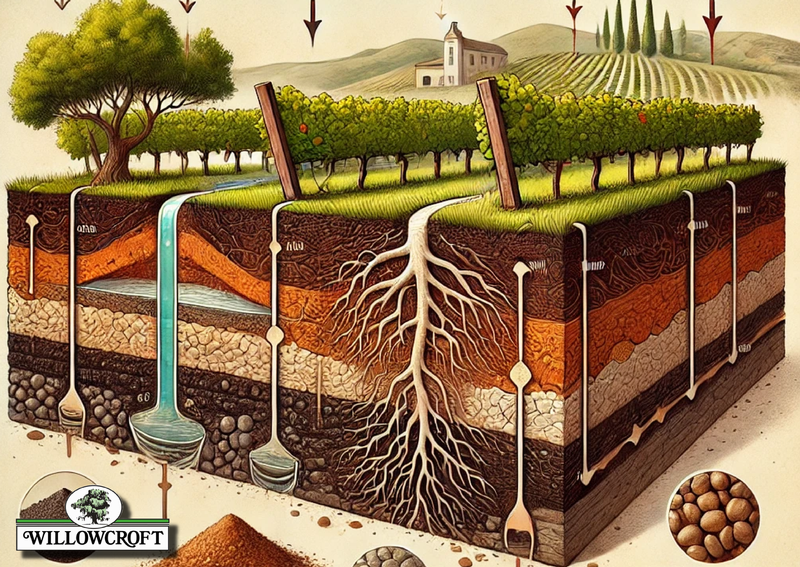 The soil in which grapevines grow plays a crucial role in winemaking, influencing everything from water management to the flavors in the final product. Understanding soil characteristics can help vintners decide to cultivate healthy vines and produce quality wines.
The soil in which grapevines grow plays a crucial role in winemaking, influencing everything from water management to the flavors in the final product. Understanding soil characteristics can help vintners decide to cultivate healthy vines and produce quality wines.
Particle Size, Drainage, and Water Retention
Soil texture—defined by the proportion of sand, silt, and clay—affects water drainage and retention, which are vital for vine health. Sandy soils have larger particles and larger pore spaces, allowing for quick drainage but limited water retention. Conversely, clay soils consist of smaller particles and smaller pore spaces, leading to slower drainage and higher water retention. Loam soils, which are a balanced mix of sand, silt, and clay, offer moderate drainage and water-holding capacity, often considered ideal for viticulture. The right balance ensures that vine roots receive adequate moisture without becoming waterlogged, promoting deep root growth and resilience.
Soil Color, Sun Reflection, and Heat Absorption
The color of soil can influence its temperature by affecting how it absorbs and reflects sunlight. Darker soils tend to absorb more heat, which can be beneficial in cooler climates by promoting earlier ripening of grapes. Lighter-colored soils, such as those rich in limestone or chalk, reflect more sunlight, potentially keeping the soil cooler and delaying ripening. This reflection can also enhance light exposure to the grape clusters, aiding in photosynthesis. Managing soil temperature through color and composition helps vintners control the ripening process and grape development.
Soil Composition and Flavor Influence
Beyond texture and color, the mineral composition of soil can subtly influence the flavor profile of wines. For instance, calcareous soils, which are rich in calcium carbonate, are known to retain water effectively and can impart a certain acidity to the grapes, contributing to a wine's freshness. Clay soils, with their excellent water retention, can produce bold and structured wines, making them suitable for varieties like Merlot and Sangiovese. While the direct impact of soil minerals on wine flavor is complex and not fully understood, the interplay between soil composition, water availability, and vine health undeniably shapes the characteristics of the wine.
In summary, a deep understanding of soil properties—including particle size, color, and composition—enables winemakers to optimize vine health and influence the sensory qualities of their wines.
From Snow to Bud Break: The Promise of a New Season in Northern Virginia Vineyards

Northern Virginia has been blanketed by more snow and colder temperatures than usual as we find ourselves in the heart of winter. Notably, early January brought significant snowfall, with areas like Leesburg receiving more than 7 inches. While the landscape rests under this frosty veil, it's heartening to remember that the vineyards will begin their annual renewal in just about six weeks.
Grapevines are dormant, appearing as mere woody twigs amidst the snow. This essential period allows vines to conserve energy and prepare for the upcoming growth cycle. As temperatures start to rise and the ground begins to thaw, the first signs of life emerge with bud break. Tiny buds swell and burst open, revealing new shoots and leaves, marking the vine's reawakening.
Following bud break, the vines enter a phase of rapid growth. Shoots lengthen, and small, self-pollinating flowers appear. These blossoms, once pollinated, develop into tiny green berries. As summer progresses, these berries undergo veraison, changing color and beginning to ripen. The grapes reach their peak ripeness by late summer to early fall, ready for harvest.
The current winter conditions, though harsh, play a crucial role in this cycle. The cold ensures that vines remain dormant, protecting them and allowing for a more synchronized and healthy bud break come spring. So, as we navigate these chilly days, take comfort in knowing that the vineyards are merely resting, gathering strength for a vibrant season ahead. In just a few weeks, we'll witness the first signs of this transformation, a testament to nature's resilience and the promise of warmer days.

